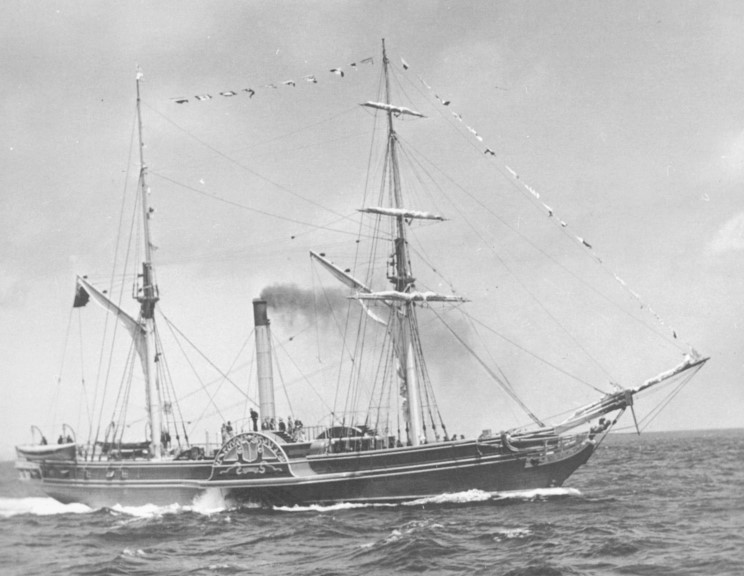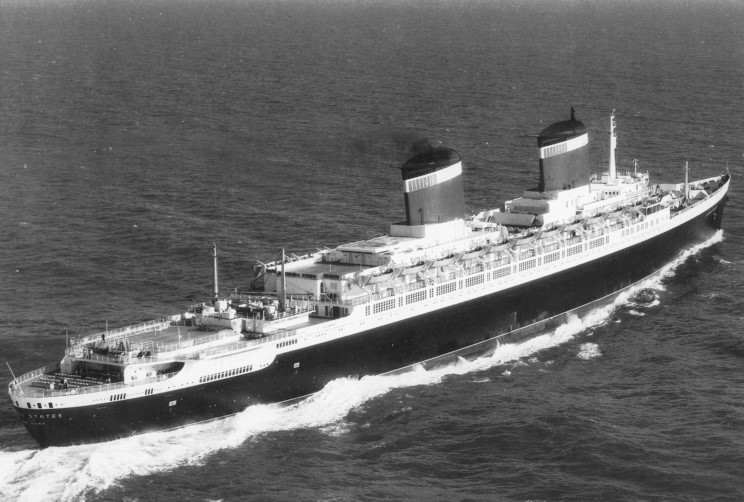|
Did the race for the Blue Riband begin on this day in 1838? Perhaps it did but, there never "really" was a Blue Riband nor was it something that steamship companies even "officially"recognized as an unofficial contest. To race ships across the ocean was something that was just not done by companies because that would be considered dangerous to the safety of the ships and the passengers. However every steamship company coveted the non-existent Blue Riband because it meant that they had the fastest ship on the high seas. And in the day of weeks long crossings, speed would pack the ships full of people who wanted nothing more than to get across the sea, quickly. In 1835 Junius Smith announced his desire to start a trans-Atlantic steamship line providing regular service between England and New York. He believed that modern ships, equipped and managed correctly, could reduce the arduous long voyages to just a couple weeks. (Can any of us imagine it taking weeks to cross the world let alone just one ocean?) Smith had arrived in England after spending 57 days crossing in a sailing packet and he was sure there was a better way. One of the first problems was money, he did not have enough, but he was able to convince several London businessmen to join him in his endeavor and thus in 1838 the British & American Steam Navigation Co. was born. Now that the money problem was cured he needed a ship. At least 3 ships crossed the Atlantic before Smith's line opened. The Savannah in 1819, Curacao in 1827 and the Royal William in 1833. Savannah and Royal William crossed only for the purpose of being sold by their owners, they had not lived up to their owners expectations and they thought that the European market would be a better place to sell them. Royal William, Samuel Cunard's first try at a steamship, was sold to the Portuguese government, but Savannah had to return to the U.S. Before she came home though, Savannah had toured the northern areas including Stockholm, Copenhagen and even St. Petersburg, Russia, where the Tsar inspected her and offered her captain, Moses Roger, a job sailing for him, Roger declined the offer. The Curacao however, could be considered to be the first steamship to provide regular service across the Atlantic. She was a Dutch ship built at Dover, England and crossed the Atlantic three times (Rotterdam to The Dutch East Indies) between 1827 and 1829. This ship is often forgotten or just completely ignored, but it holds a an important place in maritime history. Smith must have known about two of the three ships before he went looking for a builder for his ship and he must have known the immense challenge he was about to undertake. Being an American though, he possessed the American drive to make the improbable or the impossible happen. At first he wanted to build four ships, in typical American fashion ignoring all the problems of designing and building a ship to specifications never before attempted, but cooler heads prevailed and it was decided to build only one. The British Queen was to be an enormous ship for its time. She was to be 1,800 tons, an unheard of size. He contracted with the Curling & Young to build the hull and at first offered the engine contract to Robert Napier. Napier's bid was rejected as being to high and the job was given to Claude Girdwood of Greenock. The decision to give Girdwood the engine deal went bad when Girdwood went bankrupt before delivering the engine. Therefore Napier was asked to build it and he did. (For £21,000 more than he had asked originally.) But Smith was up against the wall and agreed to Napier's price. The loss of time in construction due to a delay in the engine caused the race to begin. At the same time the British Queen was being built, Isambard Kingdom Brunel was building his first ship, the Great Western. Smith was determined to be the first to open a trans-Atlantic service no matter what he had to do, and he knew the British Queen would not be ready before the Great Western so in desperation Smith chartered a small 703 ton sidewheeler from the St. George Steam Packet Co. named Sirius. The Sirius would be Smith's ace in the hole and on March 28, 1838 the Sirius sailed from London on the maiden voyage of the Smith Line. She stopped at Cork for coal and fresh water and on April 4 she set sail with 94 passengers and a crew of 37 crew bound for New York. Smith had beaten Brunel to become the first to start a trans-Atlantic service. The Sirius arrived at New York on April 23, eighteen days after leaving Cork, but only hours ahead of the Great Western. Nobody could believe it when the Great Western pulled into New York so soon after Sirius had arrived. After all the Great Western was still on her trials when the Sirius passed her on the Thames back in March. The Great Western had also grounded after a fire on board while sailing from London to Bristol. This caused fifty passengers to cancel their passage on the Great Western. Even though Great Western had departed Bristol on April 8, four days after the Sirius had left Cork, she arrived at New York the same day. Sirius had made only a little more than 8 knots while the Great Western crossed the Atlantic at the astonishing speed of 8.66 knots. This made the Great Western the fastest ship on the high seas. After this the Great Western was fully booked for her voyages while the Sirius made only one further trans Atlantic voyage. Smith's dream came to an end for him in 1841 when his steamship line went bankrupt following the loss of the President, which went missing with all 136 on board after leaving New York on March 11, 1841. The only other ship Smith had, the British Queen, was sold to Belgium. Thus one can say that the Sirius was the first ship to hold the mythical Blue Riband, but only until the Great Western arrived a few hours later. As stated before, the Blue Riband never existed, it was never officially endorsed by any organization or steamship company. The term "Blue Riband" was not even commonly used until the 20th century. The first mention of the Blue Riband was in the newspaper around 1890. Since then it was a contest, mainly conjured up by journalists and observed by everyone in the steamship business. Some captains had a blue pennant made for their ships, but that was a rare occasion. In 1935 Harold Hales, M.P. decided to donate a trophy to signify the fastest ship and commissioned the Hales Trophy. The first holder was to be the Italian liner Rex. However before the trophy was completed in August1935 the Normandie had won the Blue Riband from Rex. So the rules for the trophy, which were as fluid as those for the Blue Riband itself, were promptly changed. Hale added a three month waiting period to allow the current holder a chance to take back the trophy. Thus Rex was given the trophy and it was then passed to Normandie. The last passenger ship to hold the Blue Riband was the United States. However, it should be noted that the speed records have been broken by high speed catamarans, which could hardly qualify as a trans-Atlantic liners and the trophy was only relinquished to avoid legal fees which would be incurred challenging the validity of the claim against it. Regardless of who holds the trophy now, the maritime community generally acknowledges the SS United Stated as the true holder of the Blue Riband. So you could say the race for the Blue Riband did begin on this day even though the name would not be spoken until fifty years later. |
© 2006 Michael W. Pocock MaritimeQuest.com |
 |
| Replica of the SS Sirius, first holder of the Blue Riband.
|
 |
SS United States, the last holder of the Blue Riband.
|